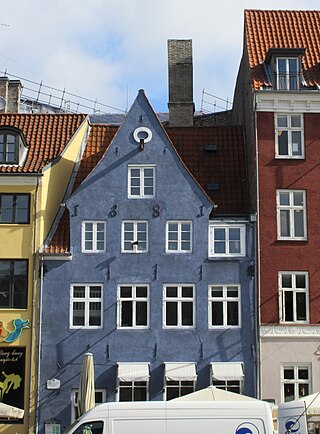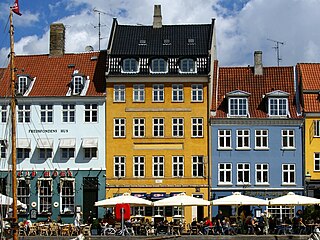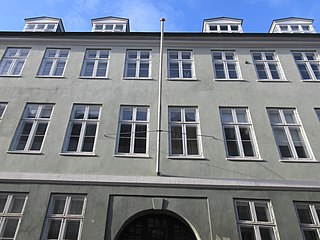
The Schottmann House Danish: is a historic property located at Strandgade 10 in the Christianshavn neighbourhood of Copenhagen, Denmark.

Nyhavn 51 is an 18th-century canal house overlooking the Nyhavn canal in central Copenhagen, Denmark.Above the door is a painted stone relief depicting a lamb. The property was formerly known as Lammet and the sign was used for identification in a time when house numbers had still not been introduced. The letters are the initials of the builder Henrich Lambertsen Engel and his wife Karen Nielsdatter Holm. The building was listed in the Danish registry of protected buildings and places in 1918. It was subject to Schalburgtage during World War II but restored. Notable former residents include the portrait painter Hans Jørgen Hammer, the marine artist Carl Frederik Sørensen and Swedish actress Eva Eklund.

Nyhavn 33 is a listed property overlooking the Nyhavn canal in central Copenhagen, Denmark. A wall stone with a compass rose, a Dannebrog and two sand glasses bears testament to the fact that the building once belonged to a manufacturer of ship sails, flafs and compasses.

The Verrayon House is a Rococo, bourgeoisie townhouse located at Lille Strandstræde 6 in central Copenhagen, Denmark. It was listed by the Danish Heritage Agency in the Danish national registry of protected buildings in 1943.

Nyhavn 67 is a listed property overlooking the Nyhavn Canal in central Copenhagen, Denmark. The writer Hans Christian Andersen lived in the building as a lodger with only short interruptions from 1848 to 1865.

Nyhavn 9 is a historic townhouse overlooking the Nyhavn Canal in central Copenhagen, Denmark. It dates back to the 17th century and is one of few buildings along the canal that was not heightened in the 19th century. The building was listed on the Danish Registry of Protected Buildings and Places in 1918. It houses a restaurant in the ground floor.

Nyhavn 13 is a historic townhouse overlooking the Nyhavn Canal in central Copenhagen, Denmark. With roots dating back to the late 17th century, it owes its current appearance to a heightening of the building with two floors in 1842. Notable former residents include the businessman Abraham Marcus Hirschsprung and the painter and educator Wilhelm Kyhn. The building was listed in the Danish registry of protected buildings and places in 1945.

Nyhavn 23 is a Neoclassical property overlooking the Nyhavn Canal in central Copenhagen, Denmark. It was listed in the Danish registry of protected buildings and places in 1918. A plaque on the facade commemorates the composer Friedrich Kuhlau, who resided there in 1832.

Nyhavn 41 is a listed property overlooking the Nyhavn canal in central Copenhagen, Denmark. For most of the 19th century, the property was owned by a family of sailmakers. The manufacturing of flags and compasses was also part of their trade. The building was listed in the Danish registry of protected buildings and places in 1918.

Lille Strandstræde 3 is a Neoclassical property in the Nyhavn Quarter of central Copenhagen, Denmark. The building was listed in the Danish registry of protected buildings and places in 1979.

Brolæggerstræde 6 is a Neoclassical property situated in the Old Town of Copenhagen, Denmark. It was listed in the Danish registry of protected buildings and places in 1950. Former residents include the later bishop Jacob Peter Mynster and the politician Balthazar Christensen.

Naboløs 1 is a Neoclassical property situated at the corner of the streets Neboløs and Læderstrlde, close to Gammel Strand, in the Old Town of Copenhagen, Denmark. Together with the adjacent buildings at Naboløs 3 and Gammel Strand 52, it was constructed by Hans Christian Ondrup as part of the rebuilding of the city following the Copenhagen Fire of 1795. It was listed in the Danish registry of protected buildings and places in 1945.

Nyhavn 47 is an 18th-century property situated at the corner of Nyhavn and Toldbodgade in central Copenhagen, Denmark. It owes its current appearance to a renovation undertaken by Julius Andreas Blom in 1842–45. It was listed in the Danish registry of protected buildings and places in 1932. Notable former residents include the merchant and shipowner Peter Christian Knudtzon.

Nyhavn 37 is an 18th-century property overlooking the Nyhavn Canal in central Copenhagen, Denmark. A distillery was based in a rear wing from before 1756 until at least the 1860s. The building was heightened with one storey in 1791. The building was listed in the Danish registry of protected buildings and places in 1923.

Nyhavn 20 is a 17th-century building overlooking the Nyhavn canal in central Copenhagen, Denmark. It was listed in the Danish registry of protected buildings and places in 1945. The building houses a bar in the basement and a residential apartment on the upper floors. The facade features a relief of a fish above the main entrance, flanked by two reliefs of sailing ships.

Nyhavn 61 is an 18th-century residential building overlooking the Nyhavn canal in central Copenhagen, Denmark. The building was listed in the Danish registry of protected buildings and places in 1945. The scope of the heritage listing was expanded in 1984. Nyhavn 61 and Nyhavn 59 have now been merged into a single property and are physically integrated on the third floor. The two buildings share a central courtyard.

Nyhavn 5 is an 18th-century property overlooking the Nyhavn canal in central Copenhagen, Denmark. It was listed in the Danish registry of protected buildings and places in 1945. Notable former residents include the actor Adam Gottlob Gielstrup, opera singer Peter Schram and businessman Cornelius Peter August Koch.

Nyhavn 17 is a late 17th-century building situated at the corner of Nyhavn and Lille Strandstræde in central Copenhagen, Denmark. It was listed on the Danish registry of protected buildings and places in 1951. Tattoo-Ole, a tattoo shop located in the basement, claims to be the oldest still functioning tattoo shop in the world.

Kvæsthusgade 1/Nyhavn 69 is a three-storey building situated at the corner of Nyhavn and Kvæsthusgade. A memorial featuring a bust of a diver wearing a diving helmet commemorates that Em. Z. Svitzer's Bjernings-Enterprise, a salvage company founded by Emil Zeuthen Svitzer back in 1833, was once headquartered in the building. Notable former residents include the actress Magda von Dolcke.

Toldbodgade 9 is a half-timbered building situated in the Nyhavn Quarter of central Copenhagen, Denmark. For about 50 years, from the 1800s until his death in 1852, the property belonged to Henning Hansen Rønne, a skipper from Bornholm, who for a period was alderman of the Skipper's Guild in Copenhagen. The building was later for a while operated as a hotel under the name Hotel Helsingborg. The building was listed in the Danish registry of protected buildings and places in 1918. In 1953, the building was bought by art dealer Viggo Clausen, who subsequently converted it into an art gallery under the name Claussens Kunsthandel. In 2018, Claussens Kunsthandel relocated to new premises at Studiestræde 14. A restaurant administration is now located in the building.




























